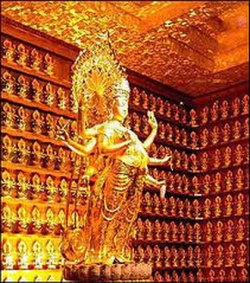What is the ''logic'' in Buddhist logic?
The history of Indian logic is usually divided into three periods, Old Nyaaya (circa 250 B.C. ) , Buddhist logic (sixth century A.D.) and New Nyaaya. The Buddhist logic text, Nyaayaprave`sa (Introduction to Logical Methods) , had great influence upon Indian and Chinese Buddhism and also among the Jains. As a pivotal work, the Nyaayaprave`sa has received critical attention from historians of religion, philologists, philosophers, and logicians. As with all advances in scholarship, there is controversy over interpretation, but in the case of Buddhist logic, the controversy cuts to the very heart of the issue of whether Buddhist logic is in any recognizable contemporary sense a "logic." The received view holds that Buddhist logic bears very close similarities to syllogistic forms and that it can be represented and analyzed by standard deductive techniques.(1) A much different and opposing view has been argued by Professor Douglas Daye in a series of papers. Daye maintains that "... the descriptive utility of mathematical logic with early Nyaaya texts has simply been overrated";(2) that although the Nyaaya texts contain metalogical rules for evaluating the "legitimacy or illegitimacy" of arguments, the distinction between validity and invalidity does not apply;(3) that Nyaaya models are not inferences but "formalistic explanations"; and that "... Buddhist logic is not deductive, nor can it be formally valid nor is it an inference."(4)
The cumulative effect of these claims is to assert that Buddhist logic is not a "logic" at all, at least not in any sense which is recognized by Western philosophers. There is a radical incompatibility between the Nyaaya methods of logic and those of the Prior Analytics or Principia Mathematica. Of course, there will be differences, possibly very great differences, between any two traditions so diverse as fourth century (B.C.) Greece and sixth century (A.D.) India, but are we to go so far as to say that the Nyaaya does not contain inferences? The radical incompatibility thesis is, I maintain, a mistake; moreover, it is a mistake which can readily be uncovered by examining the typical Nyaaya inference scheme. Of the notion that a Nyaaya scheme could be a "formalistic explanation" without being an inference, I shall say very little because I do not see how anything which functions as an explanation could not involve inferences of some kind or other. It is important to know whether the Nyaaya scheme is deductive or not, and if it is, whether all of its parts are essential to the deduction. I will demonstrate that there are two ways of reading the Nyaaya form: one which is straightforwardly deductive and a second which is best understood by what the American pragmatist, C.S. Peirce, and later Norwood Hanson, call "retroduction."
To begin with, consider this representative example from the Nyaaya:(5)
1. pak.sa (thesis) Sound is imprrmanrne
2. hetu (mark or Reason) - Because of its property of being produced
3. d.r.s.taanta (Exemplification)--Whatever is produced, is impermanent 4. sapak.sa (similar case)- As with a pot, and so forth 5. vipak.sa (dissimilar case)- As (not with the case) of space, and so forth
Tachikawa proposes the following scheme for what he calls the "three-membered Indian syllogism:(6)
6. There is property p in locus L 7. (because) there is property q (in L). 8. Wherever there is property q, there is property p, as in locus w
Clearly, if this schema is reversed, (8) and (7) become premises for a valid deductive inference of (6) as the conclusion. The reverse of our example becomes an instance of modus ponens.
9. d.r.s.taanta - Whatever is created is impermanent. 10. hetu - Sound is created. 11. pak.sa - Sound is impermanent.
Why is this instance of modus ponens a matter of dispute? The incompatibilists point out that the relationship between the thesis (pak.sa) and the justification (hetu) is always expressed in the Sanskrit ablative case and that this relationship cannot be represented or translated as the English "therefore" (or ergo). Its best translation is "because." Thus, for the incompatibilist, the primary objection to identifying the Nyaaya scheme as a deductive inference is the familiar one of ordinary language philosophers who resist the translation of expressions as `q because p' into `p ) q' on the grounds that the causal or explanatory meaning of "because" is lost in the truth-functional conditional.
This objection has force, but one must distinguish between the assertion that truth-functional connectives preserve or capture the meaning of `q because p' and the claim that truth-functional connectives can represent a deductive relationship between propositions within the Nyaaya scheme. It is the latter which the received view upholds: it is the former which the incompatibilist vehemently opposes. The issue is not joined, because surely one can maintain that there is a deductive inference in the inversion Nyaaya scheme without maintaining that it captures the meaning of or even approaches synonymy with the original. In sum, the issue between the received view and the incompatibilist pivots on the former's willingness to invert the Nyaaya form and read it as a valid deduction and the latter's insistence that the form cannot be so reversed without losing the special relationship of the hetu. Given the merits of both views and given the fact that both positions are not explicit contradictories of one another, there is a way to understand the Nyaaya scheme which allows both sides to have their cake and eat it too. I believe that the three-membered Nyaaya is best understood as a retroductivc inference. A retroduction, as it has been described by C. S. Peirce and
Norwood Hansonl is a pattern of reasoning which leads from some phenomenon or perception to an explanatory hypothesis of that phenomenon. Its form is not truth-functional nor are the relationships of that premises completely rulegoverned. Peirce said, "It must be remembered that retroduction, although hampered very little by logical rules, nevertheless, is logical inference, asserting its conclusion only problematically or conjecturally...."(7)
Retroduction does have a recognizable pattern, and indeed it is very close to the three-membered syllogism of Indian logic. Its form, according to Peirce, is:
12. The surprizing fact Q is observed.
13. But if P were true, Q would be a matter of course.
14. Hence, there is reason to suspect that P is true.
As a schema, for retroduction we have:
(12') q (13') q because p (14')p
which is isomorphic with that of the Nyaaya (that is, pak.sa, because hetu and d.r.s.taanta; hence there is evidence for the pak.sa). The similarity (sapak.sa) and dissimilarity (vipak.sa) cases serve as further evidence in support of the explanatory justification.
The philosopher of science, Norwood Hanson, argued that retroduction was a "logic of discovery" which led to deductive-nomological explanations. Like Peirce, Hanson pointed out that the reversal of a retroduction was a deductive inference 'q, q because p', becomes 'p, if p, then q, hence q'. The notion of reversal" or inverting" a retroduction is not a technique or rule of formal logic, but rather a simple psychological description of changing the order of premises.
If the three-membered syllogism is retroduction and if a retroduction is part of a retroductive-deductive pair, one should expect to find internal evidence for the presence or absence of a deductive fragment. To return to the Nyaaya and its commentary on this three-membered syllogism, is there internal evidence to treat it as a retroduction-cum-deduction? A crucial point of philological interpretation is the function of the ablative "because" and the meaning of "hetu" itself. The weakness of the standard view is that it disregards the special features of the ablative "because" and translates the three-membered syllogism as if it contained conditionals. Following Daye, I suggest that that move is too hasty, and that we must regard the ablative "because" as an operator connecting the hetu and d.r.s.taanta to the thesis. Since the Sanskrit ablative expresses a relation of physical or conceptual removal, separation, distinction, or origin, it was used to convey the notion of causal explanation. This fact gives prima facie evidence for interpreting it in the sense of "a reason for." Such an understanding is reinforced by the meaning of "hetu," which is the name of the explanatory part of the three-
membered syllogism. According to Tachikawa, "hetu" primarily means 'reason'.(8) This is solid ground for reading 'q because p' as: 'p is the reason for q', 'p is the explanatory hypothesis for q', or even the Peircean 'if p were true, q would be a matter of course'.
Beyond points of translation, one of the strongest reasons for seeing the three-membered syllogism of the Nyaayaprave`sa as a retroduction-deduction is the existence of the five-membered syllogism in the earlier Nyaaya tradition, particularly the Nyaaya Suutra.(9) The five-membered syllogism of the Nyaaya Suutra is perfectly symmetrical between its three initial retroductive steps and its two culminating deductive steps:
15. Thesis(pratij~naa) for example, there is fire on the mountain.
16. Reason (hetu)- The mountain smokes.
17. Exemplification (d.r.s.taata) - Wherever there is smoke. there is fire, as (for example) on the hearth in the kitchen.
18. Recapitulation of the reason (upanaya) - The mountain smokes.
19. Conclusion (nigamana) There is fire on the mountain.
If one were to picture this pattern as an isosceles triangle, one side would represent the retroduction from [15] the pratij~naa reasoning through the [16] hetu to [17] the d.r.s.taanta, and the opposing side of the triangle would represent the deduction beginning with [17] the d.r.s.taanta to [18] upanaya and inferring the nigamana.
The French Indologist Rene Guenon pointed out that after the appearance of the Nyaaya Suutra, there were two abridged forms of the five-membered syllogism, (10) in which either the first three [15-17] or the last three [17-19] parts appeared alone. Gutnon also pointed out that the latter abridgment resembles the syllogism of Aristolle; the former abridgment, of course, is precisely the one found in the 6th century Nyaayaprave`sa and indeed the same smoke-fire example occurs there also. Given the interpretation I have offered, it is not surprising that there should be two abridgments of the five-membered syllogism. One abridgment captures the retroductive move; the second captures the deductive move. Deduction and retroduction are inversions of one another, and they can be separated by positioning the property-locus statement. One abridgment reasons from the thesis statement to an explanatory generalization; the other abridgment deduces the thesis from the generalization. The Buddhist logicians Mere quite emphatic about which abridgment they favored. The Nyaaya quite explicitly says, "We say that these three statements make the members of the syllogism and no more! "(11) Tachikwa's gloss on this statement indicates that it is an assertion that only three statements are necessary for an inference.
We may conclude that what "inference" primarily meant to the Buddhist logicians was "reasoning to an explanatory causal hypothesis"; however, it would be wrong to further conclude that they had no appreciation of the
deductive abridgment. To them logic was a means of bringing others to a recognition of particular statements; it was an upaaya, a heuristic teaching device. The retroductive abridgment of the five-membered syllogism clearly teaches in the sence that it brings the hearer to an awareness of a causal or conceptual connection. The deductive abridgment does not "teach" in this sense because like all deductions its conclusion does not contain information nor already found in the premises, Thus, from the standpoint of an upaaya the retroductive inference is enough, or, as the author of the Nyaayaprave`sa put it, "...these three members make the [retroductive] syllogism and no more."
A further point in favour of reading the Nyaaya inference schema as a retroduction is that it makes the remainder of the manual on logical methods, especially the detailed sections on kinds of fallacies, more intelligible and enljghtening. More than two thirds of the text covers identification and classification of fallacies, but none bear any resemblance to the formal fallacies of deduction such as affirming the consequent or denying the antecedent, nor does the system resemble Western notions of an informal fallacy. Fallacies of irrelevance such as the ad hominem or post hoc propter hoc call attention to the lack of support between premises and putative conclusion. In Buddhist logic the classification of fallacies does not attempt to circumscribe the ways premises can be irrelevant; on the contrary it fives criteria for grading the strength or weakness of the explanatory hypotheses. This is precisely what is required for retroductive accuracy. Weak hypotheses emerge in three circumstances: (1) the hetu is unrecognized by proponent or opponent, (2) the hetu is inconclusive, or (3) it is contradicted. Inconclusive hetus are those which are not supported by further evidence from the similarity and dissimilarity cases; contradicted hetus are those which prove the opposite of the pak.sa. Such a contradiction is established by deducing the opposite property-locus assertion. A hetu can fail to be recognized, that is, it can fail as a teaching device by not making the auditor (or speaker) aware of the connection between the assertion statement and its warranting hetu. Thus, when hypotheses fail to be understood, they engender fallacies of recognition, but when they fail in evidential support they engender fallacies of contradiction or inconclusivity. On the whole, this classification of fallacies reflects a sophisticated, but also a commonsensical, means of evaluating hypotheses. It is open textured as retroductive reasoning must be, and more importantly it does not attempt (as the Western notion of fallac does) to classify fallacious reasoning as a kind of deductive argument gone awry.
In this paper I have attempted to enlarge the dialogue about the nature of Buddhist logic by arguing that it is essentially retroductive. As philosophers and psychologists continue to investigate the conceptual and factual aspects of hypothesis formation, the study of Buddhist logic will increase in importance because, unlike other logical treatises, the Nyaayaprave`sa is an historyically significant document about ways of reasoning and misreasoning to an explanatory hypothesis.
NOTES
1. Daniel H. H. Ingalls, Material for the Study of Navya-Nyaya Logic, Harvard Oriental Series, vol. 40 (Cambridge: Harvard University Press, 1951); Hajime Nakamura, "Buddhist Logic Expounded by Means of Symbolic Logic," Indogku Bukkyogaku Kenkyu 7 (1958) : 375-395; J. F. Staal, "Means of Formalization of Indian and Western Thought," Logic, Metlzodology and Philosophy of Science, Proceedings of the XIIth International Congress of Philosophy, Venice, 1958; H. Kitagawa, "A Note on the Methodology in the Study of Indian Logic," Indogaku Bukkyogaku Kenkyu 8 (1960) : 380-390; S. S. Barlingay, A Modern Introduction to Indian Logic (Delhi: National Publishing House, 1965) : A. Charlene S. McDermott, An Eleventh-Century Buddhist Logic of "Exists, " Foundations of Language, Supplementary Series, vol. 2 (Dordrecht, Holland: D. Reidel, 1970); B. K. Matilal, The Navya-Nyaaya Doctrine of Negation, Harvard Oriental Series, vol. 46 (Cambridge: Harvard University Press. 1968): and particularly Epistemology, Logic and Grammar in Indian Philosophical Analysis, Janua Linguarum, Series Minor, 111 (Mouton: The Hague, 1971).
2. Douglas Daye, "Metalogical Incompatibilities In the Formal Description of Buddhist Logic (Nyaaya)," Notre Dame Journal of Logic 28, no. 2 (1977): 231.
3. Douglas Daye, "Empirical Falsifiability and the Frequence of Dar`sana Relevance in the Sixth Century Buddhist Logic of Sankaravamin," Logique et Analyse 86 (June 1979): 221.
4. Douglas Daye, Comparative Issues in Buddhist and Angle-European Formal Logics (unpublished manuscript), p. 121.
5. Musashi Tachikawa, trans., "A Sixth Century Manual of Indian Logic (the Nyaayaprave`sa) ," Journal of Indian Philosophy 1, no. 2 (1971): 114.
6. Ibid., p. 115, Norwood R. Hanson, Patterns of Discovery (Cambridge: Cambridge University Press, 1958), pp. 93-105.
"Is There A Logic of Discovery," Current Issues in Philosophy of Science, edited by H. Fergland and G. Maxwell (New York: Holt-Rinehart & Winston, 1961), pp. 20-35. Also Aristotle, Prior Analytics II, 25.
7. C. S. Peirce, Collected Works (Cambridge: Harvard University Press, 1933), vol. 1, p. 188. Also vol. 6, pp. 522-28.
8. Tachikawa, p. 116.
9. A. B. Keith, Indian Logic and Atomism (Oxford: 1921), p. 21. The author dates the Nyaaya Suutra at 200-450 A.D.
10. Rene Guenon, Introduction generale a l'etude des doctrines hindous(Paris: 1930), pp. 226-227.
11. Tachikawa, p. 122.










